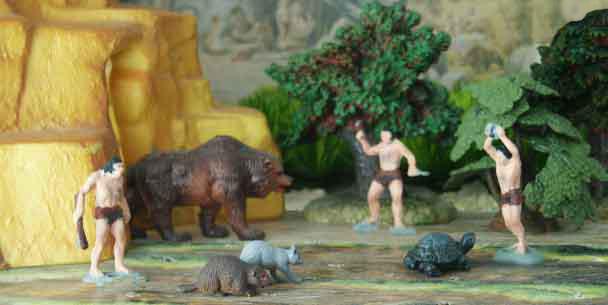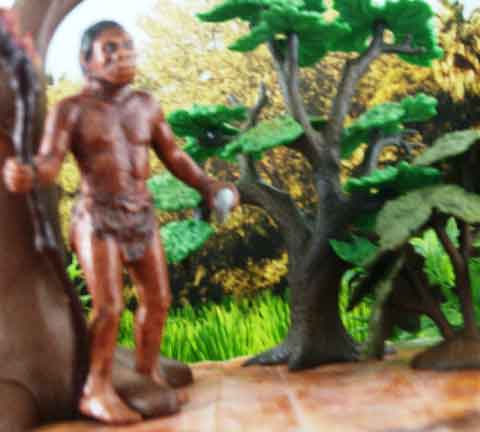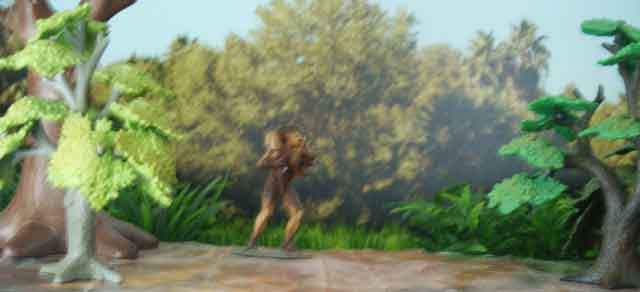
From the Dinosaur Collector
Homo erectus update 1/7/07
lived from 2 million to around 400,000 years ago in Europe, Africa, East Asia perhaps even Australia. Homo erectus can best be seen as a grade of human development. The African variants are sometimes called Homo egaster. In East Asia they were originally referred to as Sinanthropus (Peking man) and Pithecanthropus (Java man). There they appear to have been relatively static group showing little obvious change. There is evidence of erectus in Europe and they are the intuitive choice for the ancestors of the line leading to Neanderthal.. In Australia there is the Mungo man who may be erectus. H. erectus was larger that H. habilus his presumed predecessor and shows less sexual dimorphism. He had a larger brain the largest falling into the modern range. The teeth of Homo erectus is nearly identical to modern humans, although the cheek teeth remain larger, and the jaw is heavier. He used fire which makes the colonization of the northern climates practical. If he could make fire is debated. He should have had better language skills. He was a hunter not just a scavenger. Small game is certainly on the menu and erectus finds are often associated with the bones of large animals like Hippos and early elephants like Stegodon. So even big game hunting was possible. The characteristic tool associated with erectus is the stone hand axe. Fire hardened spears and clubs are also reasonable.
The links will take you to diorama showing figures from this period. The site A and Site A icons will take you to the home pages for more selections.
In Europe by the inter-glacial period of the Early Pleistocene there is Homo erectus or one the successor forms Homo heidelbergensis or Homo antecessor,both vaguely defined species. This is the group that eventually becomes Neanderthal man. The earliest find is in Georgia so they may moved into Europe from the East. Notable sites from Spain and England are also known. They are associated with the bones of Hippos and other large animals.

From the collection of Norm Fertig MPC cave men imitated the Marx figures, custom painted by Fred R Hinojosa.. With Marx and other caveman sets all you get are male cavemen. No wonder they died out. Starlux Cave Bear.
Homo erectus that stayed in Africa is often called Homo egaster. There may actually be multiple h. ergastor in Africa, the status of many the fossils found there is fluid. The hand axe is the characteristic tool for all these groups. The hand axe. appears almost everywhere that early man appears, with the exception of the very farthest east. The exact purpose and use of this triangular or oblong stone artifact remains a mystery. It may have been a general purpose tool. They could be used for cutting meat, scraping skins, chopping wood, digging holes, smashing bone or working wood. A clumsy hunting tool even? The proliferation and abundance of hand axes suggests that perhaps everyone had one, both men and women. Some seem to be too large to actually be used and they seem to found in large groups. This led to the suggestion they had a social or ritual function. perhaps males created as display objects to attract females. They may not be tools at all. They could be the left over cores from which unusable flakes are created by pressure or hammering. With the exception of the far east they are found almost every where until the end of the Pleistocene.

Bullyland Homo erectus from the evolution of man series with fire and hand axe.
In Asia Pithecanthropus or Java Man was one of the first specimens of Homo erectus to be discovered. Hand axes found everywhere else don't show up in East Asia. It is thought wood was utilized instead. This would indicate a different East Asian H. erectus culture distinct from the rest of Asia, Europe and Africa. Homo erectus appear to have stopped evolving - with the exception of a small group in the Indonesian archipelago that branched off to become Homo floresiensis (aka the Hobbit). It was believed that Homo erectus disappeared as other populations of archaic Homo evolved roughly 400,000 years ago. Evidently, this is not the case. Researchers have dated the deposits thought to contain the fossils of H. erectus near the Solo River in Java to only 50,000 years ago. This would mean that at least one population of Homo erectus in Java was a contemporary of modern humans. Many of the last generations in Asia did seem to show characteristics of modern asian populations.

Starlux Pithecanthropus.
 Click on the Site A icon for Dioramas organized by
period or by manufacturer.
Click on the Site A icon for Dioramas organized by
period or by manufacturer.